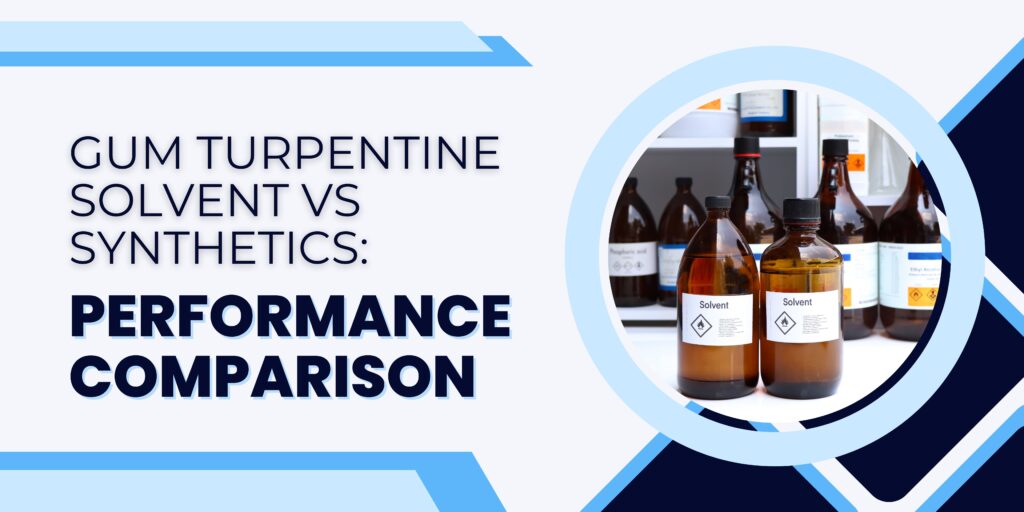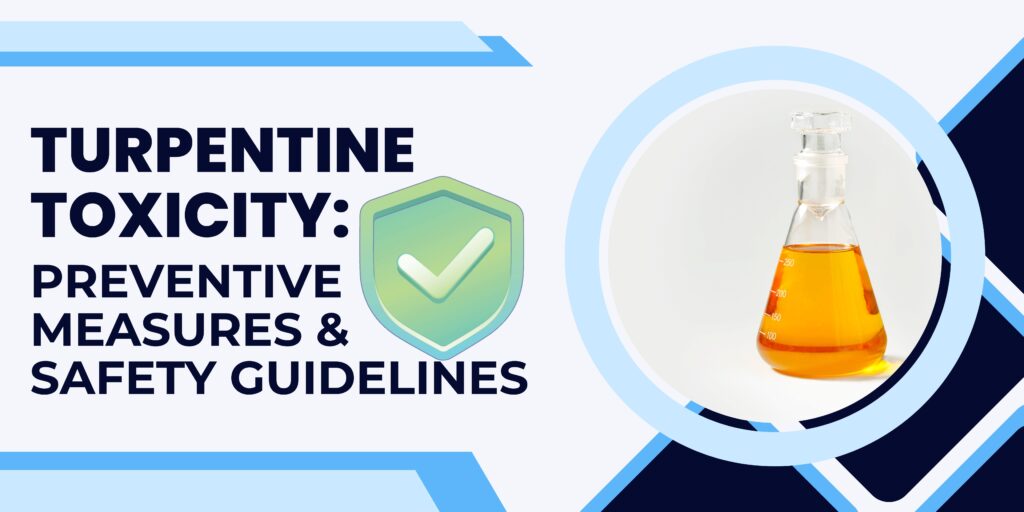
The choice of solvents in various industries has a significant impact on both performance and environmental sustainability. In recent years, there has been a growing interest in exploring alternative, eco-friendly solvents as a response to environmental concerns and regulatory changes. One such solvent that has gained attention is gum turpentine, a natural, renewable solvent derived from pine trees. This article delves into a comprehensive comparison of gum turpentine and synthetic solvents, evaluating their performance attributes and environmental impact.
What is Solvent?
A solvent is a material, usually in the form of a liquid, that has the ability to dissolve, distribute, or extract other compounds without causing them to change chemically. Solvents are widely employed in a variety of applications, including chemistry, industrial, and cleaning. They are necessary for activities such as dissolving paint, promoting chemical reactions, and cleaning surfaces because they break down and suspend particles or substances. The chemical composition, characteristics, and intended applications of solvents can vary greatly. Water, alcohol, acetone, and different organic compounds are popular solvents used in industrial and commercial processes.
Understanding Gum Turpentine
Gum turpentine, also known as gum spirits of turpentine, is a natural solvent obtained from pine trees, primarily the longleaf pine (Pinus palustris) and slash pine (Pinus elliottii). It has been used for centuries in various applications, including as a solvent in the paint and coating industry, a cleaning agent, and even in traditional medicine. The key to gum turpentine’s appeal is its sustainability and low environmental impact.
Composition of Gum Turpentine: Gum turpentine consists primarily of terpenes, which are volatile organic compounds responsible for their solvent properties. The main terpenes found in gum turpentine are alpha-pinene and beta-pinene, but it also contains other terpenes, such as limonene and camphene.
Renewable Source: Pine trees are a renewable resource, making gum turpentine a sustainable option. The extraction process involves tapping the trees, which can be done without harming or killing the tree. Unlike petrochemical solvents, which are finite and contribute to environmental degradation, gum turpentine offers a greener alternative.
Understanding Synthetic Solvent
Synthetic solvents are artificially created chemical substances designed to serve as effective solvents in various applications. These solvents are typically produced through chemical synthesis and are engineered for specific properties and functions. Unlike natural solvents such as water or oils, synthetic solvents are designed to have controlled characteristics, including solvency power, volatility, and stability, making them highly versatile for use in different industries.
Because synthetic solvents are versatile, they can be adapted to specific purposes. Solvents, for example, are designed in the paint and coating industries to dissolve and distribute pigments, resins, and other components while maintaining the desired consistency and flow characteristics. Synthetic solvents play an important role in the synthesis of numerous molecules in the pharmaceutical and chemical industries, assisting in the development of new drugs, chemicals, and materials.
While synthetic solvents provide significant advantages in terms of performance and flexibility, they also have environmental and safety implications. Many synthetic solvents are generated from petrochemical sources, and their manufacturing and use can result in difficulties such as volatile organic compound (VOC) emissions, waste generation, and potential health hazards. This has spurred interest in researching eco-friendly alternatives such as bio-based and renewable solvents like gum turpentine to alleviate these environmental problems.
Performance Comparison
Gum turpentine’s performance as a solvent is a crucial aspect to consider when evaluating its suitability as an alternative to synthetic solvents.
Solubility and Dissolving Power: Gum turpentine exhibits excellent solvency for a wide range of substances, including resins, waxes, and oils. It is known for its ability to dissolve various natural and synthetic materials effectively. In some cases, it can even outperform traditional solvents.
Viscosity and Evaporation Rate: Gum turpentine typically has a low viscosity, which makes it suitable for various applications, such as coatings and inks. Its moderate evaporation rate allows for proper working time in many industrial processes.
Compatibility: Gum turpentine is compatible with many resins and polymers, making it a versatile choice for formulators and manufacturers.
Odor and User Experience: It’s important to note that gum turpentine has a distinct, pleasant pine aroma, which can be seen as a desirable feature in some applications. In contrast, many synthetic solvents have strong, often unpleasant odors.
Health and Safety: Gum turpentine is generally considered safe to handle when appropriate precautions are taken. It is a non-carcinogenic, biodegradable solvent, which can reduce health and environmental risks.
Environmental Impact
The environmental impact of solvents is a growing concern. Synthetic solvents, derived from petrochemical sources, have raised issues related to carbon footprint, resource depletion, and emissions of volatile organic compounds (VOCs). In contrast, gum turpentine offers several advantages in this regard.
Carbon Footprint: Gum turpentine’s production has a lower carbon footprint compared to petrochemical solvents. The process of tapping pine trees and distillation is less energy-intensive and generates fewer greenhouse gas emissions.
Biodegradability: Gum turpentine is biodegradable, meaning that it breaks down naturally into harmless byproducts. This is in contrast to some synthetic solvents that can persist in the environment, leading to long-term contamination.
Reduction in VOC Emissions: The use of gum turpentine as a solvent can contribute to lower VOC emissions, which are known contributors to air pollution and health issues. Its use may help industries meet stricter environmental regulations.
Sustainable Sourcing: The pine trees used for gum turpentine production are typically managed sustainably, contributing to reforestation efforts and biodiversity conservation.
Applications of Gum Turpentine as a Solvent
Gum turpentine’s versatility allows it to be employed in various industries and applications, further enhancing its appeal as a sustainable solvent.
Paints and Coatings: Gum turpentine has a long history of use in the paint and coating industry. It is utilized as a solvent for oil-based paints, varnishes, and wood stains. Its ability to dissolve resins and improve flow and leveling makes it a valuable component in many formulations.
Inks and Printing: In the printing industry, gum turpentine is used as a solvent for inks. Its low viscosity and high solvency make it an excellent choice for formulating inks with desirable properties.
Cleaning Products: Gum turpentine is found in a range of natural cleaning products, including citrus-based cleaners and degreasers. Its ability to dissolve oils and greases, along with its pleasant scent, makes it a popular choice in this industry.
Pharmaceuticals and Fragrances: Gum turpentine’s terpenes are used in the pharmaceutical industry and fragrance production. Terpenes from gum turpentine contribute to the aroma of perfumes and the production of pharmaceutical products.
Challenges and Considerations
While gum turpentine offers many benefits, there are some challenges and considerations to keep in mind when using it as a solvent.
Cost: Gum turpentine can be more expensive than some synthetic solvents due to the extraction process and sourcing. However, as more industries adopt sustainable practices, the cost differential may decrease.
Supply Chain and Sourcing: It’s essential to ensure a consistent supply of gum turpentine, which requires sustainable forest management practices. This includes responsible tapping and reforestation efforts.
Regulatory Compliance: Gum turpentine is subject to regulations, particularly in terms of its safe handling and disposal. Companies must adhere to these regulations to ensure environmental responsibility and worker safety.
Odor: While many appreciate the natural pine scent of gum turpentine, it may not be suitable for all applications or preferences.
Conclusion
The comparison of gum turpentine and synthetic solvents reveals that gum turpentine holds great promise as a sustainable and effective solvent. Its natural origin, excellent solvency, lower environmental impact, and versatility in applications make it a compelling choice for a wide range of industries. While challenges like cost and odor must be considered, the environmental and performance advantages it offers outweigh many of these concerns.
As environmental regulations continue to tighten, and as consumer preferences shift toward sustainable products, the role of gum turpentine in the solvent industry is likely to grow. Its success in case studies, coupled with ongoing research and innovation, bodes well for the future of this renewable, natural solvent. Whether it’s in the paint and coating industry, cleaning products, or pharmaceuticals, gum turpentine is proving to be a viable and greener alternative to synthetic solvents, contributing to a more sustainable and environmentally responsible future.
In conclusion, the choice between gum turpentine and synthetic solvents ultimately depends on the specific needs of the industry and the desired environmental impact. However, the evidence suggests that gum turpentine is a solvent worth considering as a part of a greener, more sustainable future.




